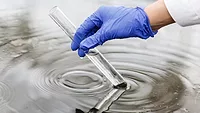Scientists Develop Test That Detects PFAS in Food Packaging, Water, Soil in Under Three Minutes

Image credit: Manki Kim via Unsplash
Researchers from the New Jersey Institute of Technology (NJIT) have developed a method of detecting toxic per- and poly-fluoroalkyl substances (PFAS) in food packaging, water, and soil samples in three minutes or less. The scientists believe their lab-based method could speed up efforts to address the pollution and accumulation of these “forever chemicals,” and could be useful in applications like public water quality testing. The new method provides results much more quickly than existing tests, with some taking hours for sample preparation and analysis.
The new method leverages paper spray mass spectrometry (PS-MS)—an ionization technique for analyzing the molecular composition of sample materials—which is 10–100 times more sensitive than liquid chromatography/mass spectrometry, the current standard for PFAS testing.
PFAS can be ionized and rapidly detected by a high-resolution mass spectrometer, which gives a clear view of each type of PFAS present and the degree of contamination, down to a parts-per-trillion (ppt) level. For more complex matrices like soil, the researchers applied a related method called desalting paper spray mass spectrometry (DPS-MS) that washes away salts which normally suppress the ion signal of PFAS. Together, the two techniques greatly improve the ability to detect PFAS. The new method’s limit of detection for PFAS is 1 ppt, which is equivalent to a single drop of water in 20 Olympic-sized swimming pools.
When testing the method, the researchers were able to detect PFAS in one minute or less in samples of microwave popcorn paper, instant noodle boxes, fast food wrappers, and other food packaging samples. The analysis revealed traces of 11 different PFAS molecules, including common types that have been linked to cancer and immune system suppression; specifically, perfluorooctanoic acid (PFOA) and perfluorooctanesulfonic acid (PFOS), both of which have been targeted by the U.S. Environmental Protection Agency (EPA) in a proposal to establish maximum contamination levels for six types of PFAS in drinking water.
When analyzing water, the researchers found traces of PFOA in tap water samples in under two minutes, while finding no traces of PFAS in samples taken from the university’s filtered fountain water. Using DPS-MS, the team also identified two species of PFAS from as little as 40 milligrams (mg) of soil in under three minutes.
Near-term, the researchers believe their technology could be extremely helpful in food safety testing. For the long-term, the detection method is being tested for use alongside cutting-edge techniques for remediating PFAS that are being developed at NJIT’s BioSMART Center. For example, in the lab, scientists were able to pair the new detection method with a novel degradation catalyst, which degrades 98.7 percent of PFAS in drinking water samples within three hours.
Looking for quick answers on food safety topics?
Try Ask FSM, our new smart AI search tool.
Ask FSM →









